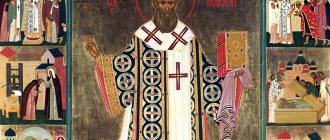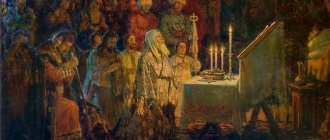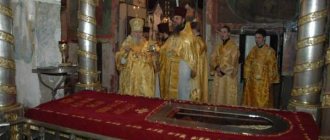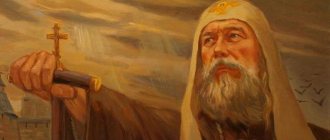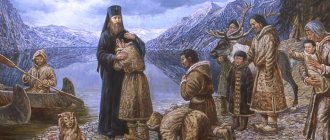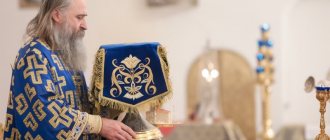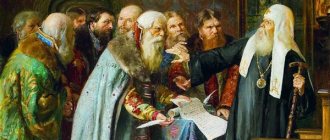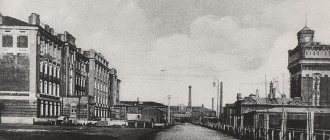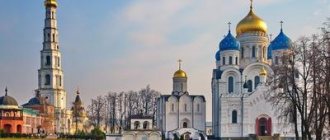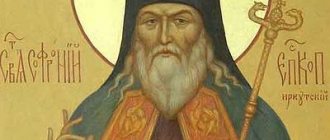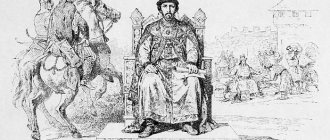| St. Innokenty of Moscow |
Innocent (Veniaminov)
(1797 - 1879), Metropolitan of Moscow and Kolomna, saint, apostle of America and Siberia [1] Commemorated on March 31 on the day of his death, September 23 on the day of glorification, February 3 along with Equal Apostles. Nicholas of Japan (ROCOR [2]), in the Cathedrals of Moscow Saints; Moscow, Radonezh, St. Petersburg and Siberian saints, as well as all the saints of North America (OCA) and Alaska (OCA)
In the world, Ivan Evsevievich Popov, then Veniaminov, was born on August 26, 1797 in the Siberian village of Anginskoye, Irkutsk diocese (now Anga, Kachugsky district, Irkutsk region), into the poor family of Evsevy Popov, a sexton of the local Ilinsk church. He was six years old when his father died. The mother was left alone with four children, and Vanya was taken in by his father’s brother, Deacon Dimitri, who served in the same Ilyinsky Church. At the age of seven, Vanya became a reader.
In 1806, Ivan entered the Irkutsk Theological Seminary. He studied well, and spent his free time in the seminary library or with his uncle, who, having become a widower, became a monk and moved to Irkutsk. Deacon Dimitri, monastically David, was a good watchmaker and self-taught mechanic, and he also captivated his nephew with his studies. At the seminary, in order to distinguish between numerous namesakes, the rector changed the surnames of many students, which is why Ivan Popov then became Veniaminov, in memory of the recently deceased Bishop of Irkutsk Veniamin. Since the Irkutsk diocese was in dire need of church and clergymen, young Ivan, a year before graduating from the seminary, married the daughter of a priest of the Annunciation Church, Ekaterina Ivanovna, and was immediately ordained a deacon to the same church. He graduated from the seminary as one of the best, and four years later he was ordained a priest.
The young priest gained the love and respect of parishioners for his kind disposition and the solemn order of worship. On Sundays, before the liturgy, Father John gathered the children to church and told them about the Christian faith, about worship, the rules of a pious and godly life. In his free time, he made clocks and musical organs with spiritual hymns, which made it possible to ensure the financial situation of the family. His mother and brother Stefan moved from Anginsky to him, the priest had a son, who was named Innokenty, and the family lived a measured life that did not foretell changes.
At the end of 1822, a new parishioner appeared in the Annunciation Church - a certain Ivan Kryukov, who had lived for forty years in the colonies of the Russian-American Company, who, with his enthusiastic stories about Russian America and the Aleuts, convinced Father John to go to this distant country. At the same time, Bishop Mikhail of Irkutsk received instructions from the Holy Synod that a priest should be sent to the island of Unalaska, to the Aleutian Islands, which were then part of the Irkutsk diocese. Father John Veniaminov also received an invitation to missionary service, but, like others, he refused. Meanwhile, Ivan Kryukov was getting ready to leave Irkutsk and made a farewell visit to Bishop Mikhail, where he met Father John. When their conversation turned to the topic of sending a priest to Unalaska, Kryukov again began to talk about the zeal of the Aleuts in the faith and his words stung the heart of priest John, who decided to go to America despite the resistance of his will, seeing God’s providence in this. The Bishop agreed, not without hesitation, and blessed the selfless determination of Father John, and on May 7, 1823, he left Irkutsk with his family.
Priest on Unalaska
The difficult journey took almost a year, and Father John and his family arrived in Unalaska on July 29, 1824. His new arrival consisted of two groups of the Aleutian Islands - the Fox and Pribylovy Islands, with a harsh climate and a population of hunting Aleuts, Creoles and a few Russians. Father John's flock was weakly strengthened in Christianity - the indigenous inhabitants of the islands sincerely accepted the Gospel gospel in 1795, when they were baptized by the hieromonk of the spiritual mission Macarius, but had only the most general ideas about God as an omnipotent and good Lover of Mankind. Thinking and asking God for guidance on what to do, Father John decided to first build a temple on the site of an already existing chapel and study the language of the islanders.
To build a church on treeless Unalaska, materials were needed, which the board of the Russian-American Company promised to help with, as well as workers, which Father John undertook to prepare himself. Using his thorough acquaintance with mechanics and the craft skills that he acquired in his youth, Father John began to teach the Aleuts carpentry, carpentry, partly plumbing and blacksmithing, brick making and masonry. In this joint work, he became closer and got to know his parishioners, their character, morals, ideas about the world, and became acquainted with their language. A year later, when the Aleut builders were sufficiently prepared, on July 1, 1825, work began on the construction of the church, which was led by Father John himself. He carved and gilded the throne and iconostasis with his own hands. On June 29, 1826, on the feast of the glorious and all-praised apostles Peter and Paul, the first church on Fox Islands was consecrated in honor of the Ascension of the Lord.
After the church was built, Father John spent most of his time traveling around the parish, kayaking from island to island, which required considerable courage and patience. His companions were only Aleut oarsmen and an interpreter. More than once, caught in a storm, they landed in a deserted place and, without food for several days, were forced to wait for a change in weather or travel through the mountains to the nearest village, carrying kayaks and all the cargo. But God sent spiritual consolations to the selfless priest - the Aleuts received him with sincere love and surprised him with his zealous fulfillment of Christian duties. Particularly noteworthy was the incident on Akun Island in Lent 1828. The population, who had never seen him before, met the priest standing on the shore, dressed up as if for a solemn holiday. Surprised, he asked them how they could find out about his arrival and received the answer that the old man Ivan Smirennikov from Rechetnoye, whom they called “shaman,” predicted his arrival and described his appearance. Having met with Smirennikov, Father John learned that he had been taught the Christian life from two “white people” - angels who began to appear to him after baptism. They told Smirennikov about the arrival of Father John and ordered him to obey him. Amazed, Father John wanted to meet with the angels, but, on reflection, he humbly decided to first communicate with Archbishop Michael of Irkutsk on this issue. When the bishop’s answer came three years later, old man Smirennikov had already died.
Father John's travels helped him learn the Aleut language and he began translating. First of all, he translated the main prayers: “Our Father”, “Rejoice to the Virgin Mary” and the Creed, then he began to translate the Gospel of Matthew.
Father did not like and did not know how to be idle. At a time when travel around the parish was impossible, Father John wrote a scholarly work, “Notes on the Islands of the Unalaska Department,” which included materials from his many years of travel diaries. The main ruler of the Company, F.P. Wrangel, once instructed him to calculate the hunting report card. Father John was always surrounded by children, his own and others, always finding something to do for them. He told them the Sacred story, played ball, walked through the mountains, collecting stones and talking about them. When a fair amount of stones had accumulated, he invited the children to lay out a path from the house to the church. In the evenings, as he once did in his homeland, he often made watches and musical organs for sale, involving children in the work.
Father John spent ten years at Unalaska, gaining not only universal love among the Aleuts, but also deep respect from the Company’s leadership. It was precisely such a priest that the Board wanted to see in the main city of Russian America - Novoarkhangelsk, and in 1834 he was transferred to St. Michael's Cathedral of the Novoarkhangelsk port, located on the western coast of the island of Sitka.
Rector of the Novoarkhangelsk Cathedral
Arriving with his family in Sitka on November 22, Father John was busy for a long time with matters related to the place of his former ministry, and did not have time to really get to know the indigenous inhabitants of the island - the Koloshes or Tlingits. Then some uncharacteristic reluctance kept him from starting preaching until the Nativity of Christ in 1835, when smallpox suddenly broke out among the ears. If he had come to them with a sermon before her, the hostile Koloshes would have attributed the infection to the new Russian shaman, but instead the Koloshes themselves reached out to the Russians, seeing that the disease did not harm them and wanting to receive a vaccination from the local doctor. After this, Father John was well received among them, but was in no hurry to baptize more people, but waited for their own desire and always asked the consent of their Toen leaders and mothers. In 1837, Father John went to the Stakhin redoubt, located on the mainland, where he celebrated the first Divine Liturgy, which also instilled respect in the local wayward and brave Koloshes, who expressed a desire to see the priest again. On Sitka, Father John set up a school for converts and their children, where he taught them the Law of God, literacy and various crafts, compiling textbooks himself. It was his responsibility to take care of the splendor of the Church of the Archangel Michael. He also did not abandon his scientific work: having completed the “Experience in the Grammar of the Aleutian-Lisevsky Language”, the priest with the same thoroughness took up the Koloshensky and Kodiak languages, keeping records of the customs and legends of the Koloshes. He did not forget his first flock, having completed the translation of the Gospel of Matthew into Aleut in 1838, translating other prayers and compiling small books about the Orthodox faith and Christian life.
Father John lived in Russian America for fifteen years, falling in love with the local population and earning the respect of the Company’s management. But for the successful establishment of Christianity in the vast American lands, much more people and funds were required than were available at that time. In addition, in Russia they could not publish his translations without Father John, since in the Holy Synod there would not have been anyone who knew the Aleut language. Then Father John asked for a long leave in order to explain to the highest Church authorities the condition and needs of the distant region and ask for help. Upon his arrival in Kronstadt on June 22, 1839, the missionary was warmly received in St. Petersburg and Moscow, his works were being prepared for publication, and fundraising was successful. But in the meantime, on November 25, 1839, his wife suddenly died, returning with the children to Irkutsk. Shocked by grief, the priest wanted to immediately go home to the orphaned children, but Saint Philaret of Moscow, who met with him, saw in this an instruction from God and began to convince Father John to take monasticism. For a whole year, Father John could not decide on this feat; he went to pray at the Trinity-Sergeevsky and Kiev-Pechersk Lavra. In the meantime, the fate of his children was settled: the daughters were admitted to the Patriotic Institute, and the sons to the theological seminary in St. Petersburg, and on November 29, 1840, Archpriest John Veniamiaminov was tonsured by Metropolitan Philaret as a monk with the name Innocent, in honor of St. Innocent of Irkutsk, to whom all these Father prayed for years, asking for help in his missionary work. The next day, the newly tonsured monk Innocent was elevated to the rank of archimandrite, and then Emperor Nicholas I wished to see him. Meanwhile, the Holy Synod decided to form a new Kamchatka, Kuril and Aleutian diocese and turned to the Sovereign with a request to approve one of the three candidates for the department. One of them was Archimandrite Innocent, whom the emperor approved. On December 15, 1840, his episcopal consecration took place.
| Saint Innocent (Veniaminov) |
Bishop of Kamchatka - Apostle of America and Siberia
On January 10, 1841, Bishop Innocent left St. Petersburg, leaving his little daughter Thekla in the capital. On March 11, he arrived in Irkutsk, from where he left in early May. His relatives were waiting for him in the village of Anginskoye - from here he sent his two sons and daughters Olga and Paraskeva to St. Petersburg, and his daughter Ekaterina, who had just married the priest Ilya Ivanovich Petelin, went with him to America. On September 27, Bishop Innocent came ashore to his diocese. Autumn and half of winter passed in Novoarkhangelsk in the first concerns about the new diocese. In 1842, Bishop Innocent began the construction of the Sitka Mission House—now the oldest building in Alaska—with a chapel dedicated in honor of the Annunciation.
As soon as navigation opened, on February 19, 1842, the bishop began a tour of his diocese. Many of the flock that became his family greeted the shepherd with tears of joy. When he arrived at Unalaska, his beloved Aleuts, after the Liturgy and sermon, presented him with extremely skillfully woven orlets from tree roots and various herbs. In the autumn of 1842 the saint went to Kamchatka. Having stayed in Petropavlovsk with his brother priest Stefan Popov all autumn, and waiting for a snowy road, Bishop Innokenty set off on dogs deep into Kamchatka. On January 10, 1843, he arrived at the Tigil fortress, where he talked with the Koryak elders, and on January 26 he reached the Drankinsky fort - the last Kamchadal village in the north-east of the peninsula, where stood the last church belonging to the Kamchatka region - the Church of St. Innocent of Irkutsk. From here the saint went to Gizhiga, and from there to Okhotsk. With his gentle manners and fatherly friendliness, he earned love among the Koryaks, Chukchi and Tungus. In September 1843, Bishop Innocent returned from a difficult and long journey through Kamchatka and the Okhotsk coast, having traveled five thousand miles on dogs and partly on reindeer.
When the bishop arrived in Novoarkhangelsk, the board of the Company built a house for him, and soon he opened a school there, where he taught children the Law of God. Saint Innocent opened a theological seminary in Novoarkhangelsk and established Orthodox missions in remote corners of the diocese. In 1844, construction began on a new cathedral in Sitka in honor of Archangel Michael. Despite many responsibilities, Bishop Innocent found time to make a clock that decorated the cathedral bell tower. On November 20, 1848, he consecrated the new cathedral church in the presence of 50 representatives of the diocesan clergy, many of whom graduated from the seminary created three years ago.
The saint was constantly in work and on long journeys throughout the diocese - in 1846, the bishop traveled across Asia, since the Kamchatka diocese expanded and its borders southwest of Okhotsk now touched the Chinese border. Then he visited Ayan and the Uda region, which had just been transferred from the Irkutsk diocese to Kamchatka. He celebrated his fiftieth birthday on the road, then returned to Sitka by the end of August 1847, and learned about his elevation to the rank of archbishop on a trip to Kamchatka in 1850. The Kuril Islands, where no more than sixty people lived, also belonged to the diocese of St. Innocent, but the bishop sent an evangelist to them in 1850.
The labors of the active archpastor and the priests of the diocese bore visible fruit in the conversion of many local residents to Christ - good and wonderful news came from different parts of the vast diocese. The special concern of the saint remained the koloshi, for whom a temple was specially built, consecrated by Bishop Innocent on April 24, 1849, where newly converted parishioners sang “Lord have mercy,” the Creed and “Our Father” in their native language. Since the Koloshes maintained the cruel custom of killing Kalga slaves after the death of their master, the ruler turned to the Synod for permission to buy slaves from the Koloshes to save them from death.
On July 26, 1852, the Yakutsk region was annexed to the Kamchatka diocese, and soon His Eminence Innokenty moved to live in the center of the annexed region - Yakutsk, where he settled on the territory of the Spassky Monastery. On April 10, 1853, the Bishop appointed his son, priest Gabriel Ivanovich Veniaminov, to serve at the mouth of the Amur - in Nikolaevsk, to preach the Word of God to the Golds, Mangunians and Neudals. In 1854, Archbishop Innocent himself went on a journey through this area. Then, returning from the Amur to Yakutsk, he began to build and improve the monastery buildings. Together with other missionaries, he began to translate liturgical texts and Holy Scripture into Yakut and Tungusic languages. The Crimean War did not interrupt the activities of the ruler - in the spring of 1855 he set off, first for a secondary survey of Yakutia, then to Ayan and from there to Amur. He was providentially late for the brig Okhotsk, which was then sunk by the enemy. Having been captured by the British in Ayan, with his humble and spiritual demeanor he managed to convince them to release not only himself, but also the Russian priest they had captured, and also to leave the Ayan port unharmed [3].
When negotiations on defining the Russian-Chinese border revived, the saint, who was an ardent supporter of the development of the Amur region, received in January 1856 a decree from the Holy Synod to travel to the mouth of the Amur. Having gathered priests who were ready to go preaching to an unknown land, the saint rafted down the river, visited Aigun where he met with the Chinese amban, and spent the entire August in Nikolaevsk with his son Gabriel and his flock, which consisted mainly of Gilyaks. Here the saint was delighted at the birth of his grandson. On the way back, the bishop encountered strong winds, fell into a wormwood on the Mae River, but returned safely to Yakutsk on December 1, 1856. Archbishop Innocent again spent the entire next year of 1857 traveling - first to the Vilyui and Olekma rivers, and then to America. In June, he left for St. Petersburg to participate in the work of the Holy Synod and stayed here for four months, settling matters with the printing of translations of the Holy Scriptures into the Yakut language and meeting with his daughter, the nun Polyxenia. On January 21, 1858, Saint Innocent left for Irkutsk, and from there to the Amur, a vast region that had just been annexed to Russia. Having toured all the Amur villages, Archbishop Innokenty again stayed with his son in Nikolaevsk and arrived in Yakutsk in early autumn. Here it turned out that his cells in the Spassky Monastery burned down, and with them the manuscripts of translations and scientific works. But the saint did not have time to grieve, since with the annexation of the Amur region he had a significant increase in worries, although his burden was lightened by the vicar of New Archangel Peter in America and the widowed priest Peter Popov, who decided to accept monasticism and become a vicar bishop of Yakutia. After his consecration, Archbishop Innokenty in 1860 again went to the Amur and to the south of his huge diocese - in Blagoveshchensk he gave orders for the construction of a bishop's house, in Nikolaevsk he was delighted with the birth of his second grandson, and then he was going to sail to Kamchatka, but contrary winds prevented him and brought to Port De-Kastri, and then back to Nikolaevsk for the winter. Here he gave valuable instructions to the young hieromonk Nikolai (Kasatkin), the future enlightener of Japan, and presented him with his award pectoral cross.
Thus, sometimes exposed to dangers at sea and on rivers, Saint Innocent continued his missionary service in the Amur region. His flock grew quickly; among the residents there were many good Christians who, having barely settled in a new place, began building churches. Every year, during his travels, the bishop consecrated two or three new churches. He arrived early for the consecration of the temple and always had a box with carpentry tools with him. He built the throne himself, and the next day he consecrated it. In those villages where there were churches, Archbishop Innocent certainly celebrated the liturgy, and where there was neither a church nor a chapel, there he held hours, mass or prayer services in the open air for the assembled people. After the service, he always talked with the residents: he taught them not only to pray, but also to work, offered advice on agriculture, raising livestock and other worldly wisdom, even beekeeping, and always presented parishioners with small icons and crosses. Golds continued to be baptized; through the efforts of Archbishop Innocent, a church and a school were established for them.
Vladyka Innokenty felt the approach of old age - his eyesight was weakening, his strength and good health began to leave him. He wrote a letter to Metropolitan Philaret, in which he expressed his desire to retire to the monastery. But the Moscow saint asked him not to leave his flock, to take care of his eyesight and health for the sake of serving the Church - “May the Lord tell you what is pleasing to Him, and what is good for you and His Church,” he ended his message. This was the last letter from the elder metropolitan - in November 1867 he reposed. Vladyka Innocent grieved his death, since they had been connected by friendship for more than a quarter of a century.
| Saint Innocent of Moscow |
Metropolitan of Moscow
On January 18, 1868, an urgent message from St. Petersburg arrived in Blagoveshchensk, deeply striking St. Innocent, about his appointment as Metropolitan of Moscow, successor to St. Philaret, on January 5 of that year. After receiving the dispatch, Bishop Innocent spent the whole day in solitude and prayer, and on February 15, after the liturgy and prayer service, together with his son and faithful assistant Father Gabriel, he set off for Moscow. The bishop spent the days of Great Lent in his native Irkutsk, and during Holy Week he retired to the Ascension Monastery, where he often and for a long time prayed at the relics of his heavenly patron Saint Innocent of Irkutsk. After the Easter celebrations, Vladyka visited his native Anginsky, where he bowed to his family graves for the last time and blessed his fellow countrymen and loved ones. Everywhere along the way, the bishop's train was greeted with festive ringing and cordial meetings with a large crowd of people. In Perm, for the feast of the Holy Trinity, the saint stayed for several days, and in Kazan he found a letter from the sovereign and a white metropolitan hood with a diamond cross, which he placed on himself at the shrine of St. Gury of Kazan. On May 25, 1868, the saint was greeted by the Mother See of Moscow.
Soon, the life of Metropolitan Innocent flowed as usual: he got up at four o’clock in the morning and prayed for an entire hour in his chapel. Every morning he attended the liturgy and without his blessing they did not begin the service; he never missed a single all-night vigil. From nine in the morning and almost the whole day, the reception of visitors of all ranks and classes continued. Among them there were many needy and poor people, whom the saint often helped with money from his savings. In the evenings, his grandchildren or son Gabriel sometimes read something for him, since he could no longer read or write on his own. In the evening before going to bed, he also prayed in solitude for about an hour, and went to bed neatly at ten o’clock in the evening.
The simplicity of Metropolitan Innocent was extraordinary. Priests and laymen, noble and ordinary people, came to him freely, often at odd hours, with various concerns and needs. The Lord treated everyone without feigned importance or severity. He did not like official proceedings with a stream of government papers: he settled many misunderstandings and quarrels peacefully in his office. In his attitude towards his subordinates he was paternally condescending, but he knew how to delicately put a proud man in his place. In the summer, Vladyka often lived in the village of Cherkizovo near Moscow, behind the Preobrazhenskaya Gate, where there was a temple in the name of Elijah the Prophet and a bishop's dacha with a house church.
Without changing his custom, the Metropolitan repeatedly toured the churches and monasteries of his diocese, the size of which, unlike in the past, was much smaller. Through his efforts, a school for girls from the clergy, an icon painting school, and an almshouse for poor widows and orphans were created. But the Saint did not like praise and always said: “The merit does not belong to me, many worked with me. This happened with me, but it was arranged by the will of God.” He was always sincerely perplexed when people admired his apostolic travels: after all, he only had to get ready, and then they took him everywhere!
However, Saint Innocent was fading: his vision was getting worse, his strength was leaving him. He wanted to retire and settle in the Gethsemane monastery of his beloved Trinity-Sergius Lavra, but Emperor Alexander II rejected his requests. The inaction forced by blindness put him in a sad mood, but he remained clear-minded and loved company and conversation. January 5, 1878 marked ten years since his appointment as Metropolitan of Moscow, and on this occasion the Moscow clergy gathered at the Trinity Courtyard, presenting him with a gift of the richly decorated Iveron Icon of the Mother of God.
The year 1879 came, and the saint almost never got up from his chair due to severe dizziness. Anticipating the approach of death, he re-read the will he had drawn up long ago and ordered to donate money from his own capital to the church of his native village of Anginsky. During Great Lent, without changing his custom, Vladyka daily asked to be taken to church for the duration of the service; on Sundays he would certainly partake of the Holy Mysteries of Christ. During Holy Week, the Iveron Icon of the Mother of God, especially revered by Metropolitan Innocent, was brought to the Metropolitan’s chambers from the chapel at the Resurrection Gate. He asked to be lowered to his knees and, having prayed reverently, with tears in his eyes, venerated the miraculous image. As those around him noticed, he became somehow especially calm. The next day, the sacrament of unction was performed on the sick person. On the eve of Maundy Thursday, Saint Innocent ordered that the Liturgy be served in the morning earlier than usual. Already at three o'clock in the morning they came to the bishop with the Holy Gifts, he ordered himself to be put on his feet and firmly and clearly read the prayer: “I believe, Lord, and confess that You are truly the Christ, the Son of the living God.” Having received communion, his face lit up and repeated several times: “Thank you, Lord! I thank You that You have granted me, unworthy, to partake of Your Holy Mysteries in full consciousness!” In the evening of the next day, the bishop asked to read the funeral service over him, then said goodbye to his loved ones, saying a few words of edification to each one. They read the departure document again, the bishop fell into oblivion, but then, waking up, he asked:
- What, have you finished reading already?
They told him that they had finished.
- Why don’t they say: “Amen”? - he asked. The reader repeated:
- Amen!
The Bishop crossed himself and said:
- God's will be done!
These were his last words. On Holy Saturday, March 31, 1879, the great worker and new apostle, Saint Innocent of Moscow, died a quiet Christian death in the eighty-second year of his life.
In the morning of the following day, the bell of Ivan the Great announced this sad event to Muscovites. Many rushed to the Trinity courtyard to say goodbye to the deeply revered archpastor and pray for the repose of his soul. In his spiritual testament the saint humbly wrote:
“I ask and beg you not to make any speeches, either before, during, or after my burial... But if anyone would like to say a word for general edification, then I ask him to say a word from the text
from the Lord his ways are corrected to a person,
indicating to me who and where I was - who and where I died - to the glory of God, but without any praise for me
.
Saint Innocent was solemnly buried in the Spiritual Church of the Trinity-Sergius Lavra, next to the grave of his friend and mentor, Metropolitan Philaret.
Prayers
Troparion, tone 1
Thy message went out into all the midnight countries, / for they that received thy word, / which thou didst most gloriously teach, / thou didst enlighten the ignorant of Christ with the light of the Gospel, / decorating human customs or thou art,/ Russian praise, to our holy holy father Innocent,/ pray to Christ God // to be saved to our souls.
Troparion, tone 3
The first teacher to the dark pagan tribes, / the first proclaimer of the path of salvation to them, / who labored apostolically in the enlightenment of Siberia and America, / Our Hierarch Innocent, / Vlada We pray to all/ to grant universal peace// and great mercy to our souls.
Kontakion, tone 4
You were a true and unfalse teacher: / commanded by the Lord Himself, / whom you taught and punished the children who came to piety, / you admonished the infidels to know in the true faith,/ enlightening them with Holy Baptism./ For this reason the apostles rejoice, // accepting honor of the evangelist of Christ.
What do they pray to Innocent of Moscow for?
Orthodox Christians in their prayers ask St. Innocent, Metropolitan of Moscow, for healing of mental and physical disorders, as well as blessings and consolation.
Prayer to Saint Innocent for protection
Oh, Saint Innocent of Christ, newly-minted saint! We fall to you, servants of God (names), and pray: fill our hearts with your love, with which you were filled with God and your neighbors in your life. Pray to Christ God, that our sins, voluntary and involuntary, may be forgiven us, that we may be delivered from all enemies, visible and invisible, from all troubles and sorrows and all sorts of ailments: may those who stand before and worship your icon, the imams of you, a never-ending prayer book and primate for us, to the Lord, and With gratitude and love we magnify the glorified and obedient you, in the Trinity glorified God, the Father and the Son and the Holy Spirit, now and ever, and unto the ages of ages. Amen.
Proceedings
Saint Innocent left behind many translations of liturgical texts and Holy Scripture into a number of languages, especially Aleutian. He compiled the alphabet and grammar of the Aleut-Lisev language and translated the Catechism, the Gospel and many prayers into it. His works on geography, ethnography and linguistics gained worldwide fame in their time. In 1833, he wrote in the Aleut language one of the best works of Orthodox missionary work, “Indicating the Path to the Kingdom of Heaven,” which has now been translated into different languages and has gone through dozens of reprints.
Teachings
Saint Innocent was a wonderful preacher - performing liturgies, prayer services and all-night vigils, he invariably instructed his flock. As he said: “Only he who abounds in faith and love can have lips and wisdom, but the hearts of those who listen cannot resist it.”
Accompanying his son, priest Gabriel Veniaminov, with his young wife on the Amur expedition to preach to the goldies, the saint blessed him with these words:
“Go to the great work God has shown you! But be careful not to grow cold in your heart in working for Christ’s field! Die on it, and do not look back until you have fulfilled your duty.”
.
Devoted to the will of God throughout his life, he left a covenant of faith to his successors, pointing to the words of the prophet: “The Lord makes man’s feet straight” (Ps. 36:23).
Saint Innocent (Veniaminov), Metropolitan of Moscow (1797–1879)
1862-1868. Blagoveshchensk, 6 years old
In the 50s of the 19th century, Russia sought to protect its Far Eastern borders from the British.
At this time, the Qing Empire suffered setbacks in the 2nd Opium War with England. This encouraged China to look to Russia as a geopolitical ally, allowing it unimpeded navigation on the Amur, and later to make territorial concessions. The expedition of G.I. Nevelskoy in 1849 proved the navigability of the Amur mouth, which gave the river strategic importance. The saint set off on his first rafting on the Amur in 1856, studying the left bank and looking for convenient places for settlement. The result was his study “Something about the Amur”, in which the saint argued for the state need for the development of the Amur, as well as the creation of a heavy Pacific fleet.
The lowland near the mouth of the Zeya seemed to the saint a place suitable for settlement and a possible center of river navigation: “Before the mouth of the Zeya, at the foot of the last mountains... there should be a city and no less than a provincial one.” In 1856, the Ust-Zeya Cossack post was founded here, where in 1857 Bishop Innocent sent the missionary priest Alexander Sizogo. The priest's family became the first family of the future city.
On May 21 (New Art), 1858, the saint founded the Annunciation Church here, the Ust-Zeyskaya village was renamed Blagoveshchenskaya, and in July of the same year - the city of Blagoveshchensk. The Governor-General of Eastern Siberia N.N. Muravyov deviated this time from the custom of naming settlements after his neighbors and associates: the village of Ekaterino-Nikolskaya (in honor of the Frenchwoman Ekaterina Nikolaevna, the wife of the Governor-General), Korsakovo (in honor of M.S. Korsakov, governor of the Trans-Baikal region), Kazakevichevo (in honor of P.V. Kazakevich, governor of the Primorsky region). He gave the name Blagoveshchensk in honor of the first place of service of St. Innocent in the Irkutsk Annunciation Church and the church of the same name in the new city.
On May 28, 1858, Saint Innocent with a solemn speech greeted N.N. Muravyov in Blagoveshchensk after the signing of an agreement in Aigun, China, on the transfer of the left bank of the Amur to Russia. The river communication between Siberia and Primorye along the Amur River was the only transport artery of that time, turning Blagoveshchensk into a leading transit center.
In 1859, Saint Innocent transferred the episcopal see of the Kamchatka diocese to Blagoveshchensk, the city turned into the spiritual center of the Far East. The first concern of the saint in the new place was the construction of a seminary and his own residence. The entire church clergy and choir were housed in the bishop's house (now the territory of a shipbuilding plant). The new house “turned out... very cold, so in the cold I didn’t go out of my fur coat and warm boots,” the saint writes about his living conditions.
In 1862, a theological school was opened in Blagoveshchensk (since 1871 - a seminary). On his annual travels around the Amur, the saint lays foundations for new churches, often making wooden altars for them with his own hands out of his love for carpentry. Over 17 years, 30 churches, several schools and two missions appeared in the Amur region. In total, by 1869, there were 111 churches and about 200 chapels in the Kamchatka diocese.
The saint wanted to send missionaries to Manchuria, but this project encountered serious difficulties. A missionary with knowledge of the Manchu language, sent from the Russian Spiritual Mission in China, died shortly after arriving in Blagoveshchensk. In the hope of raising his own cadres, Bishop Innokenty in 1864 introduced the Manchu language into the curriculum of the theological school. The first missionary, Hieromonk Roman Tsyrenpilov, went to Manchuria a year after Innocent left for Moscow, but did not achieve tangible results. But the missions of the Golds and Tungus were quite successful. In 1857, Innocent's son, Archpriest Gabriel, baptized 154 golds; in 1866, a church and a school were built near the golds, and all residents along the banks of the Amguni River were baptized. In total, in 1865, 11 missions of different nationalities were constantly operating in the Kamchatka diocese.
In his project for settling the Far East, Saint Innocent gave preference not to exiles, but to entire villages of settlers exempt from military service, Transbaikal Cossacks and families of schismatics.
The shortage of personnel - the most acute problem in the Far East - was also felt among the clergy. Even in Yakutia, the bishop was faced with the fact that many priests had previously been “exiled” here to the periphery from Irkutsk for offenses. Moreover, the Amur region, with colonization having barely begun, seemed to the priests a place of exile and punishment. However, benefits and increased salaries made it possible to alleviate the acute personnel problem in a short time. Already in 1859, 50 applications for admission to service in the Kamchatka diocese were submitted.
In his report to the Holy Synod, the saint gives an interesting assessment of the moral state of the clergy of the Kamchatka diocese in comparison with central Russia: “The local natives... for all their enviable simplicity and kindness, are much more prone to intoxication than the natural Russians, and yet their character and mind are weaker than that of those".
The distance of priests from each other “hundreds of miles” in the Kamchatka diocese made it difficult for them to confess to themselves. This issue required changes in canonical life. Saint Innocent proposed to allow written confession of priests to their confessors. But Metropolitan Philaret of Moscow approved the right of the priest in such cases to perform the rite of confession over himself.
In 1867, in Blagoveshchensk, the saint received the news of the sale of Alaska and the abolition of the Russian-American Company. At the insistence of the saint, a clause was included in the sale agreement regarding the preservation of churches in Alaska in the ownership of the Orthodox Church, and a certain annual percentage was used to maintain these churches.
Later, the saint achieved the creation of a separate Aleutian and Alaskan diocese with a see in San Francisco. On his recommendation, liturgical texts were translated into English, and any American could become a clergyman.
Literature
- The works of Innocent, Metropolitan of Moscow, collected by I. Barsukov
, book. 1-3, Moscow, 1886-1888. - Letters of Innocent, Metropolitan of Moscow and Kolomna
, book. 1-3, St. Petersburg, 1897. - Barsukov, I.P., Innocent Metropolitan of Moscow and Kolomna according to his writings, letters and stories of contemporaries
, Moscow, 1883. - Journal of the Moscow Patriarchate
: - Alekseev, V., “The Most Reverend Innocent, Metropolitan of Moscow,” 1949, No. 7, 36-44.
- 1955, № 1.
- Evlogiy (Smirnov), archim., “The life and apostolic works of Metropolitan Innocent (Veniaminov) (1797-1879)”, ZhMP
, 1975, No. 3, 58-65. - “Canonization of the Apostle of North America and Siberia, Metropolitan of Moscow and Kolomna Innocent (Veniaminov)”, 1977, No. 12, 3.
- 1977, № 12, 58-65.
- Fialkin, V., “St. Innocent, Metropolitan of Moscow, and his missionary activity,” 1979, No. 3, 70-71.
- 1979, № 4, 73-77; № 5, 73-77; № 6, 68-77.
- Skurat, K. E., “Saint Innocent, Metropolitan of Moscow, in the last years of his life,” 1981, No. 9, 68-70.
, 1976, No. 6.
, Moscow, 1983, 130-161.
, 1983, No. 33 (2385).
, 1994, №4, №9.
, ed. "Syntagma", 1999.
Innocent Metropolitan Moscow, Apostle of Siberia and America , ed. "Danilovsky evangelist".
Travel troubles
In 1838, Father John Veniaminov went to St. Petersburg to work on expanding the missionary work. He returned from there three years later as the Bishop of Kamchatka, Kuril and Aleutian and with a new name, given to him when he was tonsured into monasticism - Innocent.
The saint took charge of the largest and most sparsely populated diocese in the world. And he traveled along it on the means of transportation most adapted to harsh conditions - dog sleds.
Click on the picture to enlarge
From November 1842 to April 1843, Bishop Innocent traveled more than 5,000 kilometers - partly by sea, partly on dogs. Vladyka often had to spend the night in snowdrifts in forty-degree frosts - the icy wind did not even allow him to put up a tent. The blizzard sometimes lasted for several days. For rescue in such cases, there were yurts at every fifty kilometers. In them, travelers could find shelter and spend the night. The yurt was a fragile log frame with a hearth (chuval).
But often travelers did not have time to reach the shelter by nightfall. Then they dug through the snow to the ground, made something like a lair, lit a fire at the entrance, and so, in a snow hole, they spent the night. At the same time, all the clothes first became damp, then froze, and had to be changed.
Click on the picture to enlarge
Other troubles also happened along the way: the sleigh would break, the trail would be lost, a hungry bear or a pack of wolves would come out to meet the travelers... But Vladyka Innocent accepted all this with complacency: “Glory and thanksgiving to the Lord, who wonderfully protects me in all my ways! - he wrote. “The dress has long dried out and is worn, my side hurt for about two months and stopped, and they pulled me out of the hole a long time ago.”
Used materials
- Alexander (Mileant), bishop, “Saint Innocent, Enlightener of Alaska,” Missionary Leaflet
, 2002: - Complete Troparion. — Publishing house "Trinity". - 2006. - T. 1. - P. 66.
[1] In the ROCOR it is called equal, See Trinity Orthodox Russian Calendar for 2022 - Holy Trinity Monastery. Tѵpografїѧ Ave. Іωва Pochaevskagω in Jordanville, 2022, p. 23, .
[2] Trinity Orthodox Russian Calendar for 2022 - Holy Trinity Monastery. Tѵpografїѧ Ave. Іωва Pochaevskagω in Jordanville, 2022, p. 23, .
[3] Zacchaeus (Wood), archim., “St. Innocent of Moscow, educator of the Far East, America and Alaska,” speech at a meeting in memory of St. Innocentia (Veniaminova) October 6, 2007,
Descent into the gorge on harnesses
Archpriest and traveler Prokopiy Gromov, who accompanied Bishop Innocent on his trips, recalled an extraordinary story that happened in 1843 on the way from the port of Ayan to Okhotsk.
When Vladyka left the village of Lesnoy, where he had rested for several days with his brother, also a priest, he had to climb 70 miles onto a mountain ridge that ended in a cliff. Having approached a cliff along which it was necessary to descend into a dark gorge, he said: “Well, now I see the face of Kamchatka.” How can we be here? — If you please, take off your fur coat and put on your kukhlyanka (that’s what a fur jacket is called).
The Kamchadals tied something like iron horseshoes with spikes under his shoes, then wrapped a belt around him and prepared to lower him. - How will you get down? - Vladyka Gromov asked. - Like a child, on the deer skin that I’m wearing, I’ll jump down, like the guys ride on Maslenitsa. And to prevent it from drifting away, I’ll take the oshtol (pole for steering a dog sled) in my hands so that if I accelerate too quickly, I’ll rest on it, and in two minutes I’ll be at the bottom of the gorge.
This is what Gromov did, and from below, from the gorge, he watched as several Kamchadals supported the belt with which the bishop was tied, and one of them cut steps in the snow in front of him. So they lowered Vladyka Innocent to the bottom of the gorge.
Usually, at this pass, the dogs, divided into groups, were tied with belts into large “balls” and lowered one by one into the gorge. Then each sled (the cart pulled by the dogs) was lowered separately. This whole operation lasted two hours.
Click on the picture to enlarge
Meanwhile, in the gorge, surrounded on all sides by ridges, fires were lit, where the expedition members warmed themselves and prepared tea or food.
Recommendations
- https://days.pravoslavie.ru/Life/life1591.htm
- https://oca.org/fs/st-innocent-of-alaska
- https://www.patriarchia.ru/db/text/284047.html
- https://www.episcopalchurch.org/lectionary/innocent-alaska-bishop-1879-0
- https://www.episcopalchurch.org/lectionary/innocent-alaska-bishop-1879
- https://www.episcopalchurch.org/lectionary-calendar/2019-03
- https://days.pravoslavie.ru/Life/life6607.htm
- https://www.russiaeguide.com/trinity-lavra-of-st-sergius.html
- https://www.stsl.ru/languages/en/
- ^ a b
Sister Joanna, "The Life of St. Innocent of Alaska", Monastery of St. Innocent of Alaska, Redford, Michigan - ^ a b c
"The Most Reverend Bishop of Alaska Innocent (Veniaminov)", Orthodox Church in America - Garrett, Paul D., "Innocent, Veniaminov (Ivan Popov-Veniaminov)", Biographical Dictionary of Christian Missions
, (ed. Gerald H. Anderson), New York: Macmillan USA Sourcebook, 1998, p. 320 - [1] “The Orthodox Church in America - Hymn of the Akathist to Saint Innocent of Moscow, Equal to the Apostles and Enlightener of North America,” last addressed December 27, 2011.
- [2] “March 31/April 13: Saint Innocent of Moscow, Equal-to-the-Apostles and Enlightener of America,” last accessed December 27, 2011.
- [3] “St. Innocent of Moscow Russian Orthodox Church - Biography of St. Innocent of Moscow,” Access date 2011-12-27
- https://www.episcopalchurch.org/lectionary-calendar/2020-03
Holiness
October 6 [OPERATING SYSTEMS. September 23] 1977 The Russian Orthodox Church, acting at the official request of the Orthodox Church in America, glorified (canonized) the Innocent as a saint, giving him the title "Illuminator of the Aleuts, Apostle of America."
The Festival of the Innocents is celebrated by the Orthodox Church three times a year: March 31, the day of death according to the Julian calendar (April 13 AD); October 6, anniversary of his canonization (September 23 O.S.); October 18 - Council of Moscow Saints (October 5, O.S.).
Innocent is widely venerated as Equal to the Apostles[13][14]as the Orthodox Apostle of America.[15]
On the liturgical calendar of the Episcopal Church (USA), Innocent is celebrated on March 30.[16]
early life and education
Saint Innocent was born Ivan Evseevich Popov (Ivan Evseevich Popov) on August 26, 1797 in the family of a church minister in the village of Anginskoye, Verkholensky District, Irkutsk Governorate, in Russia. His father, Yevsey Popov, died when Ivan was six years old, and Ivan lived with his uncle, a parish deacon, in Anga.[10] In 1807, at the age of 10, Ivan entered the Irkutsk Theological Seminary,[11] where the rector renamed him Veniaminov in honor of the recently deceased Bishop of Irkutsk Veniamin.
In 1817 he married the daughter of a local priest named Catherine. On May 18 of the same year, Ivan Veniaminov was appointed deacon of the Annunciation Church in Irkutsk.[11]
After finishing his studies in 1818, Veniaminov was appointed as a teacher in a parish school. On May 18, 1821, he was ordained a priest to serve in the Annunciation Church in Irkutsk. In Russian he was known as Father John,
religious version of Ivan.
